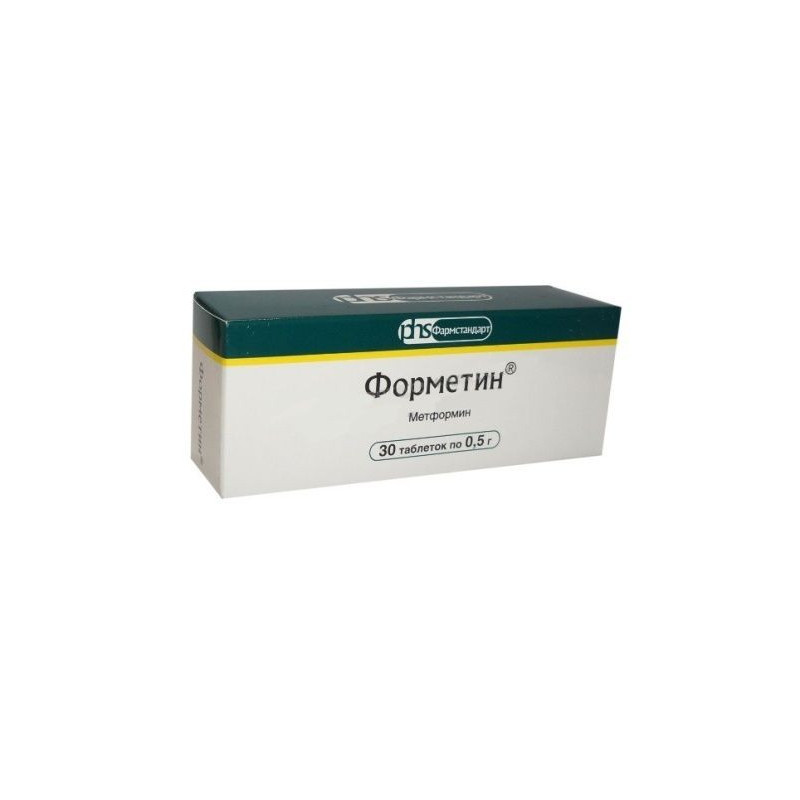



 All payments are encrypted via SSL
All payments are encrypted via SSL
 Full Refund if you haven't received your order
Full Refund if you haven't received your order
Oral hypoglycemic drug
Oral hypoglycemic drug from the group of biguanides. It inhibits gluconeogenesis in the liver, reduces the absorption of glucose from the intestine, increases peripheral glucose utilization, and also increases the sensitivity of tissues to insulin. It has no effect on insulin secretion by pancreatic β-cells, does not cause hypoglycemic reactions.
Reduces triglycerides and LDL.
Stabilizes or reduces body weight.
It has a fibrinolytic effect due to the suppression of a tissue-type plasminogen activator inhibitor.
Suction
After oral administration, Metformin is absorbed from the gastrointestinal tract. Bioavailability after taking the standard dose is 50-60%. Cmax after ingestion is achieved after 2.5 h.
Distribution
Practically does not bind to plasma proteins. Accumulates in the salivary glands, muscles, liver, kidneys.
Removal
Excreted unchanged with urine. T1/2 is 1.5-4.5 hours
Pharmacokinetics in special clinical situations
With impaired renal function, the drug may accumulate.
- diabetes mellitus type 2 with the ineffectiveness of diet therapy (especially in patients with obesity).
Set individually, taking into account the level of glucose in the blood.
The initial dose is 500 mg 1-2 times / day or 850 mg 1 time / day. In the future, gradually (1 time per week), the dose is increased to 2-3 g / day. The maximum daily dose - 3 g.
The daily dose exceeding 850 mg is recommended to be taken in 2 doses (in the morning and in the evening).
Have elderly patients daily dose should not exceed 1 g.
Due to the increased risk of lactic acidosis, when prescribing metformin to patients with severe metabolic disorders, the dose should be reduced.
The drug is intended for long-term use.
Tablets should be taken during or after a meal, without chewing and washing down with a sufficient amount of liquid.
Gastrointestinal: nausea, vomiting, metallic taste in the mouth, lack of appetite, diarrhea, flatulence, abdominal pain.
Metabolism: rarely - lactic acidosis (requires discontinuation of treatment), with long-term use - hypovitaminosis B12 (impaired absorption).
Hemic and lymphatic: in some cases - megaloblastic anemia.
On the part of the endocrine system: hypoglycemia (when used in inadequate doses).
Allergic reactions: skin rash.
- diabetic ketoacidosis, diabetic precoma, coma;
- Severe renal dysfunction;
- abnormal liver function;
- acute alcohol poisoning;
- severe infectious diseases;
- conditions that may contribute to the development of lactic acidosis, incl. heart and respiratory failure, acute phase of myocardial infarction, acute cerebrovascular accident, dehydration, chronic alcoholism;
- lactic acidosis and indications of it in the anamnesis;
- serious surgeries and injuries (in these cases, insulin therapy is indicated);
- use within 2 days before and 2 days after conducting radioisotope or radiological studies with the introduction of iodine-containing contrast agent;
- compliance with a low-calorie diet (less than 1000 calories / day);
- pregnancy;
- lactation period (breastfeeding);
- hypersensitivity to the drug.
It is not recommended to use the drug in patients older than 60 years who perform heavy physical work, due to the increased risk of lactic acidosis.
Formetin® contraindicated for use during pregnancy and lactation (breastfeeding).
The drug is contraindicated in violations of the liver.
The drug is contraindicated in severe renal impairment. During the period of use of the drug should monitor renal function. At least 2 times a year, as well as the appearance of myalgia should determine the content of lactate in the plasma.
During the period of use of the drug should monitor renal function. At least 2 times a year, as well as the appearance of myalgia should determine the content of lactate in the plasma.
Formetin may be used in combination with sulfonylurea derivatives or insulin, with particularly careful monitoring of blood glucose levels.
Influence on ability to drive motor transport and control mechanisms
When used as a monotherapy, the drug does not affect the ability to drive vehicles and work with mechanisms.
The combination of Formetin with other hypoglycemic drugs (sulfonylurea derivatives, insulin) may lead to hypoglycemic states, which impair the ability to drive vehicles and other potentially dangerous activities that require increased attention and quickness of psychomotor reactions.
Symptoms: may develop lactic acidosis with a fatal outcome. The cause of lactic acidosis may also be the accumulation of the drug due to renal dysfunction. The early symptoms of lactic acidosis are general weakness, nausea, vomiting, diarrhea, a decrease in body temperature, abdominal pain, muscle pain, lowering blood pressure, reflex bradycardia, further increased respiration, dizziness, impaired consciousness and coma.
Treatment: when signs of lactic acidosis appear, treatment with metformin must be immediately stopped, the patient is urgently hospitalized and, having determined the concentration of lactate, the diagnosis is confirmed.Hemodialysis is most effective for removing lactate and metformin from the body. If necessary, conduct symptomatic therapy.
With simultaneous use with sulfonylurea derivatives, acarbose, insulin, NSAIDs, MAO inhibitors, oxytetracycline, ACE inhibitors, clofibrate derivatives, cyclophosphamide and beta-adrenergic blockers, the hypoglycemic effect of metformin may be enhanced.
When used simultaneously with GCS, oral contraceptives, epinephrine (adrenaline), sympathomimetics, glucagon, thyroid hormones, thiazide and "loop" diuretics, phenothiazine derivatives and nicotinic acid, the hypoglycemic action of metformin may be reduced.
Cimetidine slows down the excretion of metformin, and as a result, the risk of lactic acidosis increases.
Metformin can weaken the effect of anticoagulants (coumarin derivatives).
When taken simultaneously with ethanol may develop lactic acidosis.
With simultaneous use of Nifedipine increases the absorption of metformin and Cmaxslows excretion.
Cationic drugs (amlodipine, Digoxin, morphine, procainamide, quinidine, quinine, Ranitidine, triamterene, vancomycin) secreted in the tubule, compete for canalicular transport systems and with prolonged therapy can increase Cmax drug by 60%.
List B.The drug should be kept out of reach of children, dry, protected from light, at a temperature not higher than 25 ° C.
